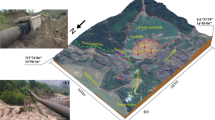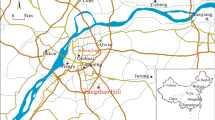Abstract
The Qianjiangping landslide is a large planar rock slide which occurred in July 14, 2003 shortly after the water level reached 135 m in the Three Gorges Reservoir, China. The landslide destroyed 4 factories and 129 houses, took 24 lives, and made 1,200 people homeless. Field investigation shows that the contributing factors for the landslide are the geological structure of the slope, the previous surface of rupture, the water level rise, and continuous rainfall. In order to reveal the mechanism and failure process of the landslide, numerical simulation was conducted on Qianjiangping slope before sliding. Based on the characteristics and the engineering conditions of the landslide, the topography and the geological profiles of Qianjiangping slope before sliding is reconstructed. The seepage field of Qianjiangping slope before sliding was simulated with the Geostudio software. The results show that ground water table rises and bends to the slope during the rise of water level, and the slope surface becomes partially saturated within the period of continuous rainfall. Using the ground water table obtained above, the failure process of Qianjiangping slope is simulated with the Flac3D software. The results demonstrate that the shear strain increment, displacement, and shear failure area of the slope increased greatly after the water level rose and continuous rained, and the landslide was triggered by the combined effect both of water level rise and continuous rainfall. The development of shear strain increment, displacement, and shear failure area of the slope shows that the landslide was retrogressive in the lower part of the slope and progressive in the upper part of the slope.


















Similar content being viewed by others
References
Angeli MG, Buma J, Gasparetto P et al (1998) A combined hillslope hydrology/stability model for low-gradient clay slopes in the Italian Dolomites. Eng Geol 49:1–13
Berilgen MM (2007) Investigation of stability of slopes under drawdown conditions. Comput Geotech 34:81–91
Cervi F, Ronchetti F, Martinelli G (2012) Origin and assessment of deep groundwater inflow in the Ca’ Lita landslide using hydrochemistry and in situ monitoring. Hydrol Earth Syst Sci 16(11):4205–4221
Dai FC, Deng JH, Tham LG et al (2004) A large landslide in Zigui County, Three Gorges area. Can J Geotech Eng 41(6):1233–1240
Debieche TH, Bogaard TA, Marc V (2012) Hydrological and hydrochemical processes observed during a large-scale infiltration experiment at the Super-Sauze mudslide (France). Hydrol Process 26(14):2157–2170 (Special Issue: Hydrology of Clay Shales and Clayey Sediments)
Ebel B, Loague K, Borja RI (2010) The impacts of hysteresis on variably saturated hydrologic response and slope failure. Environ Earth Sci 61(6):1215–1225
Evje S, Hiorth A, Madland MV et al (2009) A mathematical model relevant for weakening of chalk reservoirs due to chemical reactions. Netw Heterog Media 4(4):755–788
Guglielmi Y, Cappa F et al (2008) Mesoscale characterization of coupled hydromechanical behavior of a fractured-porous slope in response to free water-surface movement. Int J Rock Mech Min Sci 45:862–878
He KQ, Li XR, Yan XQ et al (2008) The landslides in the Three Gorges Reservoir Region, China and the effects of water storage and rain on their stability. Environ Geol 55(1):55–63
He KQ, Wang SQ, Du W et al (2010) Dynamic features and effects of rainfall on landslides in the Three Gorges Reservoir region, China: using the Xintan landslide and the large Huangya landslide as the examples. Environ Earth Sci 59(6):1267–1274
Igwe O, Mode W, Nnebedum O, Okonkwo I, Oha I (2014) The analysis of rainfall-induced slope failures at Iva Valley area of Enugu State, Nigeria. Environ Earth Sci 71:2465–2480. doi:10.1007/s12665-013-2647-x
Jian WX, Wang ZJ, Yin KL (2009) Mechanism of the Anlesi Landslide in the Three Gorges Reservoir, China. Eng Geol 108(1–2):86–95
Jiang JW, Ehret D, Xiang W et al (2011) Numerical simulation of Qiaotou Landslide deformation caused by drawdown of the Three Gorges Reservoir, China. Environ Earth Sci 62(2):411–419
Jiang QH, Zhang ZH, Wei W (2012) Research on triggering mechanism and kinematic process of Qianjiangping Landslide. Disaster Adv 5(4):631–636
Lane PA, Griffiths DV (1998) The assessment of stability of partially submerged slopes. Source: Proceedings of the Eighth International Offshore and Polar. Eng Conf 1:628–634
Lepore C, Kamal SA, Shanahan P, Bras RL (2012) Rainfall-induced landslide susceptibility zonation of Puerto Rico. Environ Earth Sci 66(6):1667–1681
Li SD, Li X, Liu YH, Sun XS (2008) Geological evolution process of sliding zone in Qianjiangping landslide. Hydrogeol Eng Geol 35(2):18–23 (in Chinese with English abstract)
Li DY, Yin KL, Leo C (2010) Analysis of Baishuihe landslide influenced by the effects of reservoir water and rainfall. Environ Earth Sci 60(4):677–687
Liang H, Li P, Zhou A (2007) Chemical characteristics of saturated loose rocks in Badong, Three Gorges reservoir. In: Proceedings of 12th International Symposium on Water-Rock Interaction (WRI-12), Kunming, pp 1399–1402
Liao QL, Li X, Dong YH (2005) Occurrence, geology and geomorphy characteristics and origin of Qianjiangping landslide in Three Gorges Reservoir area and study on ancient landslide criterion. Chin J Rock Mech Eng 24(17):3146–3153 (in Chinese with English abstract)
Liu YR, Tang HM (2009) Rock mechanics. Chemical Industry Press, Beijing
Luo XQ, Xu KX, Xiao SR, Wang ZJ, Zhang ZH et al (2007) The formation mechanism of Qianjiangping landslide in the Three Gorges Reservoir, China. Research report, pp 13–69 (in Chinese)
Luo XQ, Wang FW, Zhang ZH (2009) Establishing a monitoring network for an impoundment-induced landslide in Three Gorges Reservoir Area, China. Landslide 6(1):27–37
Macfarlane DF (2009) Observations and predictions of the behaviour of large, slow-moving landslides in schist, Clyde Dam reservoir, New Zealand. Eng Geol 109(1–2):5–15
Pinyol NM, Alonso EE, Corominas J et al (2012) Canelles landslide: modelling rapid drawdown and fast potential sliding. Landslides 9(1):33–51
Tokashiki N, Aydan Ö (2011) Kita-Uebaru natural rock slope failure and its back analysis. Environ Earth Sci 62(1):25–31
Újvári G, Mentes G, Bányai L (2009) Evolution of a bank failure along the River Danube at Dunaszekcső, Hungary. Geomorphology 109(3–4):197–209
Van Asch TWJ, Hendriks MR, Hessel R et al (1996) Hydrological triggering conditions of landslide in varved clays in the French Alps. Eng Geol 42:239–251
Wang ZH, Yang RH (2005) The activity characteristics and movement style of Qianjiangping landslide in the Three Gorges Reservoir region. Chin J Geol Hazard Control 16(3):5–11 (in Chinese with English abstract)
Wang ZH, Yang RH, Wang Y (2003) An airborne remote sensing survey of Qianjiangping landslide in Zi-Gui Shanxisha Town. Remote Sens Land Resour 57(3):5–9 (in Chinese with English abstract)
Wang FW, Zhang YM, Huo ZT et al (2004) The July 14, 2003 Qianjiangping landslide, Three Gorges Reservoir, China. Landslides 1(2):157–162
Wang FW, Zhang YM, Huo ZT et al (2008) Mechanism for the rapid motion of the Qianjiangping landslide during reactivation by the first impoundment of the Three Gorges Dam reservoir, China. Landslides 5(4):379–386
Wang G, Xie MW, Chai XQ, Wang LW, Dong CX (2013) D-InSAR-based landslide location and monitoring at Wudongde hydropower reservoir in China. Environ Earth Sci 69(8):2763–2777
Wen BP, Shen J, Tan JM (2008) The influence of water on the occurrence of Qianjiangping landslide. Chin Hydrogeol Eng Geol 35(3):12–18 (in Chinese with English abstract)
Xiao SR, Liu DF, Hu ZY (2007) Study on geomechanical model of Qianjiangping landslide, Three Gorges Reservoir. Rock Soil Mech 28(7):1459–1464 (in Chinese with English abstract)
Yadav SK, Chakrapani GJ (2006) Dissolution kinetics of rock-water interactions and its implications. Curr Sci 90(7):932–937
Yeh HF, Lee CH (2013) Soil water balance model for precipitation-induced shallow landslides. Environ Earth Sci 70(6):2691–2701
Yin YP, Peng XM (2007) Failure mechanism on Qianjiangping landslide in the Three Gorges Reservoir region. Chin Hydrogeol Eng Geol 34(3):51–54 (in Chinese with English abstract)
Zhang JF, Li ZG, Qi T (2005) Mechanism analysis of landslide of a layered slope induced by drawdown of water level. Sci China Ser E Eng Mater Sci 48(S):136–145
Zhang MS, Dong Y, Sun PP (2012) Impact of reservoir impoundment-caused groundwater level changes on regional slope stability: a case study in the Loess Plateau of Western China. Environ Earth Sci 66(6):1715–1725
Acknowledgments
The authors wish to thank the National Natural Science Foundation of China (No. 40972184 and No. 41272306) and Opening fund of State Key Laboratory of Geohazard Prevention and Geoenvironment Protection (Chengdu University of Technology) (SKLGP2012K021) for this scientific research grant. They appreciate the support received from The China Three Gorges University and the headquarters of the Three Gorges Geological Disaster Prevention, Chinese Ministry of Land and Resources, for providing the literature on the Qianjiangping landslide. The authors sincerely wish to thank Fanhe Meng, Fusong Fan, Tingting Zhang, and Li Zhou from the China University of Geosciences (Wuhan) for their constructive comments on the numerical simulation.
Author information
Authors and Affiliations
Corresponding author
Rights and permissions
About this article
Cite this article
Jian, W., Xu, Q., Yang, H. et al. Mechanism and failure process of Qianjiangping landslide in the Three Gorges Reservoir, China. Environ Earth Sci 72, 2999–3013 (2014). https://doi.org/10.1007/s12665-014-3205-x
Received:
Accepted:
Published:
Issue Date:
DOI: https://doi.org/10.1007/s12665-014-3205-x




